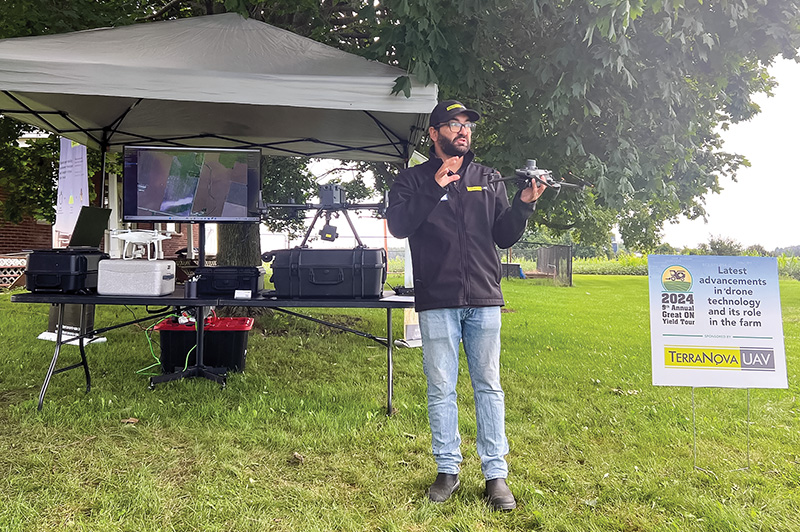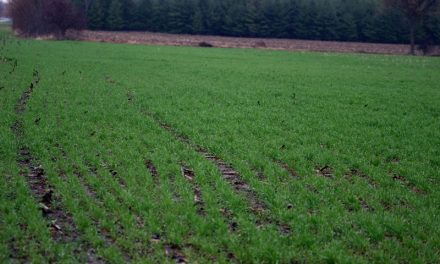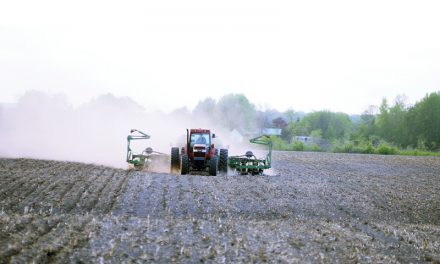Andres Hurtado, a co-founder of TerraNova UAV Drone Services explains the different capabilities of the drones used by his company and how they work with their clients to achieve the best outcome. “It’s working together so we can learn more and, you know, find new ways to implement drone technology”. Tinkess Photo
CHESTERVILLE – There was probably no one happier to see the sun shining Thursday morning than the organizers of the 2024 Great Ontario Yield Tour (Eastern) event. After a week of heavy rain, there were a few wet spots and a bit of mud, but with the sun shining brightly and a wealth of information free for the taking, it looked to be a productive day.
The ninth-annual event started with registration, coffee, and snacks before attendees headed off to the first of seven (7) presentations. With the attendees divided into five groups, the presenters had a chance to catch their breath occasionally.
The presenters covered a wide range of topics and included were the following:
- GPS Ontario – New autonomous tractor technology demo with Sabanto and sprayer mixing station demo.
- Hensall Coop – Food Grade Market Outlook & Crop Progress
- Maizex – Hybrid Management: How can we use Hybrid Characteristics to Get More Yield
- NutriAg – Managing Crop Stress to Maximize Yields
- Taurus Ag – Fertility Focused Farming
- TerraNova UAV – Latest advancements in drone technology and its role on the farm
- Shaun Casteel – A conversation about your season.
Casteel, an Associate Professor of Agronomy and a soybean specialist from West Lafayette, Indiana would also be the keynote speaker over lunch.
While some of the topics were geared specifically to those who grow soybeans and corn, others attracted a broader base with applications that could be beneficial in multiple genres.
GPS Ontario, with their autonomous tractor technology were popular at last year’s event and seemed to attract even more attention this year, at least partly because of the variety of tasks it can complete.
“So, since the event here last year, we’ve done about 58 missions with that tractor,” said Jordan Wallace, precision agriculture system specialist. “We’ve done everything from running a stone rake to tillage tools, primary and secondary tillage. We’ve run turf mowers and grass mowers, era aggravators in the turf industry, as well as coring tools and a green grill.
“So, you know, going out and overseeding a pasture field where you really don’t want to be bouncing around in it all day long, becomes something that becomes easy to do. We run Bush hogs and mowers and all that kind of fun stuff with it. So, it’s as simple as basically planning out a mission on the software, giving it what obstacles are in the field.
In terms of cost, Wallace says depending on the use case, the payback period can be relatively short. “There’s a lot of opportunity and a lot of places for these tractors, and not a lot of expense and cost,” he said. “When you start looking at what it takes to put somebody on that season and run in turf mowing scenarios were less than a year return on investment on an employee.”
Jordan Bickell from Hensall Co-op provided a very timely presentation considering that when he spoke, Canada’s rail transportation industry was still in a strike/lockout state. (The federal government would intervene later in the day). He said if it was a short-term problem, it wouldn’t hurt them too much, but if it went to say, ten days. It would be an issue.
“We have about 50 to 80 containers, 20-foot containers, leave Hensall every day,” said Bickell. “They go to a to a rail yard in Toronto.
A question was asked about how Hensall contracts are structured and Bickell said it was straight forward.
“We contract by the acre,” he said. “We typically have a contract price that’s so many bags of production per acre on those acres. So typically, 1500 pounds and 15 bags price it so much, and then you produce that crop and deliver it all to us, and at the end of the year, at that time, then we’ll decide, you know, what the value of those of the over contract amount is. It’s based on the factors that I just really talked about. It’s demand for all these market classes. Yes, some go up, some go down, but they’re really fairly static. The thing that drives price is how much has been produced, how much supply there is in the market.
But what happens if you don’t reach those 15 bags per acre?
“Yes, that is a good question, because our contracts are fairly unique,” added Bickell. “You’re not obligated. They all have an act of God clause in them and that’s based, basically, because we have a large contract base, and hopefully we can average out alright, and we’ll be okay.”
Throughout the morning several of the members of each group could be seen looking towards the sky, and you would have to forgive them for doing so. Drones just have that kind of effect on people. This particular drone was part of TerraNova UAV presentation.
Andres Hurtado is a co-founder of TerraNova UAV drone services (www.terranova-uav.com) and his presentation concentrated on the different tools his company has at their disposal and the services they can provide.
“The drones at the end of the day are just a tool,” said Hurtado. “What really matters is what we can produce, and how you can really create value, and how you can increase yields, reduce input costs, save on time, so many things, that’s what really matters. But let’s start just by talking about the tool that we use, which is drones, which produce high resolution aerial images.”
Hurtado then talked about each of the drones he had with him. The first was a multi- spectral drone which had several cameras. It could take regular images like the eye can see, but it also has the capability to read red edge and a near infrared, bands of the spectrum that the human eye cannot see. With this lens you can detect colour change even before the plant becomes visibly discoloured. “This is great because, for example, if you’re scouting, you have, you know, one of these maps, and then you go to one of these areas, and these plants look nice and green, but for some reason, the maps are showing, you know, potential areas of concern,” said Hurtado. “Then you might want to take a tissue sample, or you might want to take a soil sample, because chances are that something is happening, and then you can be proactive and take some preventative actions.”
The latest addition to TerraNova UAV is a drone with LiDAR capability which can allow them to complete a 3-D reconstruction of an entire field, which is beneficial for tiling projects or determining the topographical characteristics even with vegetation as the laser can penetrate it.
“It’s always been about a lot of potential applications, and it’s all about having the discussion with different stakeholders, especially with the growers,” said Hurtado. “It’s working together so we can learn more and, you know, find new ways to implement drone technology”
With minds full and stomachs empty, the morning wrapped up with a BBQ lunch and a chance to network. Special Guest Speaker – Shaun Casteel spoke on Setting and Expanding on Foundations to Maximize Soybean Yield, followed by a 2024 Grain Market & Basis Outlook by Moe Agostino and the 2024 Ontario Yield Tour Results (Moe Agostino and Henry Prinze.)













